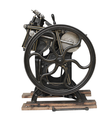Creative Inkscape effects in practice
|
The first article of this two-part series [2] introduced the effects toolkit of the leading free vector graphics program, Inkscape. In this article, I'll show how to create some real artworks based on these techniques.
Getting Started
You can start by creating a slightly oriental, shiny pattern (Figure 1, bottom right), which is quite easy to do in Inkscape. For the intricate pattern, you can use a photo from a Persian wall mosaic [3] (Figure 1, top left), which you can trace with Inkscape's vectorizing tool and create the image you see in Figure 1, top right.
This image would end up having too many nodes to manipulate comfortably, so you should reduce it in advance to 1,000 pixels wide.
[...]
Buy this article as PDF
Pages: 5
(incl. VAT)






